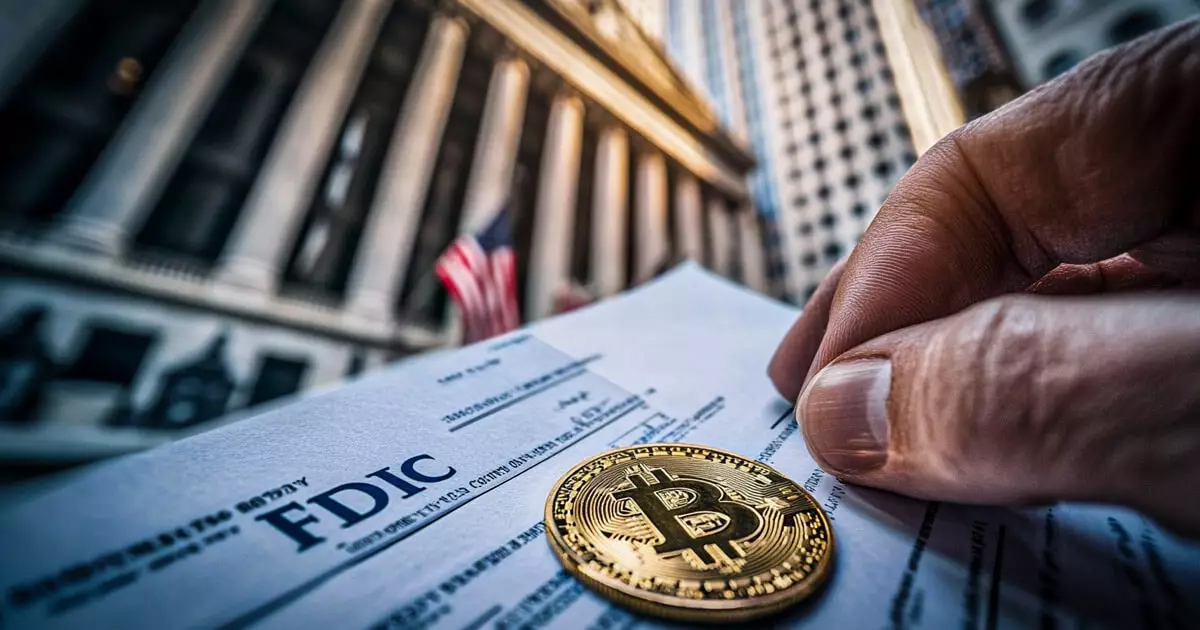The Federal Deposit Insurance Corporation (FDIC) is on the verge of revising its policies regarding banks that engage in cryptocurrency-related activities, as reported on February 5. This anticipated shift marks a significant departure from the agency’s previous cautious stance, potentially enabling banks to dabble in certain digital asset offerings without undergoing the extensive prior regulatory scrutiny that has characterized the landscape thus far.
The proposed alterations to the FDIC’s guidelines represent an essential recalibration in the relationship between traditional banking institutions and the burgeoning world of cryptocurrencies. Banks are reportedly advocating for the provision of crypto custody services and are exploring the concept of tokenized deposits — digital representations of value situated within the confines of a bank’s traditional checking account framework. This exploration indicates a marked evolution in how banking infrastructure is poised to integrate blockchain technology, especially for customers who desire cryptocurrency benefits without relinquishing their familiarity with conventional bank services.
The FDIC’s release of 175 documents pertinent to its oversight of crypto-engaged banks correlates with an increasing appetite among financial institutions for more straightforward guidelines. This shift becomes even more notable in light of the agency’s previous issuance of “pause letters” to 24 banks in 2022, requesting that they halt or refrain from offering crypto-related services. Such actions not only illustrate the FDIC’s initial apprehension but also underscore its growing recognition of the necessity for adaptability in a rapidly changing financial landscape.
In a statement shared by FDIC Acting Chairman Travis Hill, the released documents reflect a commitment to enhanced transparency, particularly in relation to the Freedom of Information Act (FOIA). This release was prompted by a FOIA request filed by Coinbase in October 2022, which sought clarity on an alleged 15% deposit cap affecting banks favoring cryptocurrencies. However, the response was shrouded in redactions, leading to accusations of opacity by Coinbase’s Chief Legal Officer Paul Grewal, who argued that important information remains concealed.
Hill pointed out that the replies to banks seeking to expand into crypto services were largely met with skepticism and resistance from the FDIC. The documents reveal a consistent pattern of requests for more information from banks, characterized by prolonged silence from the regulator, cumulatively creating an environment of uncertainty. Many banks, overwhelmed by such interactions, effectively ceased their efforts to navigate the regulatory landscape for crypto-adjacent offerings.
Strategies of Compliance and Resistance
Grewal has voiced concerns regarding what he identifies as “regulation by exhaustion,” a tactic where banks were compelled to respond to regulatory inquiries and subsequently faced delays that pressured them into abandoning their crypto aspirations. The documented exchanges cited the volatility of Bitcoin, reputational risks, and consumer protection concerns as primary reasons for the FDIC’s hesitance in permitting banks to proceed with their crypto-related services.
Caitlin Long, the founder and CEO of Custodia Bank, also highlighted troubling aspects of the FDIC’s internal communications, indicating that the word “deposit” had significant implications for banks considering engagement with cryptocurrency. The insinuation for banks to steer clear of crypto deposits indicates an underlying reluctance to embrace technological innovation that could support digital currencies denoted in traditional fiat terms.
As the financial landscape continues to shift with the integration of digital assets, the FDIC’s forthcoming revisions to its guidelines signal a potential pivot towards a more accommodating regulatory framework. While this outcome could facilitate banks’ entry into cryptocurrency services, it also raises critical considerations surrounding consumer protection and financial stability.
What remains to be seen is how effectively the FDIC can balance the need for innovation within the banking sector while ensuring safeguarding measures against the inherent risks associated with cryptocurrencies. Ultimately, as banks navigate these evolving guidelines, a cooperative spirit between regulatory bodies and financial institutions will prove crucial in adapting to this brave new world of digital finance.



















Leave a Reply